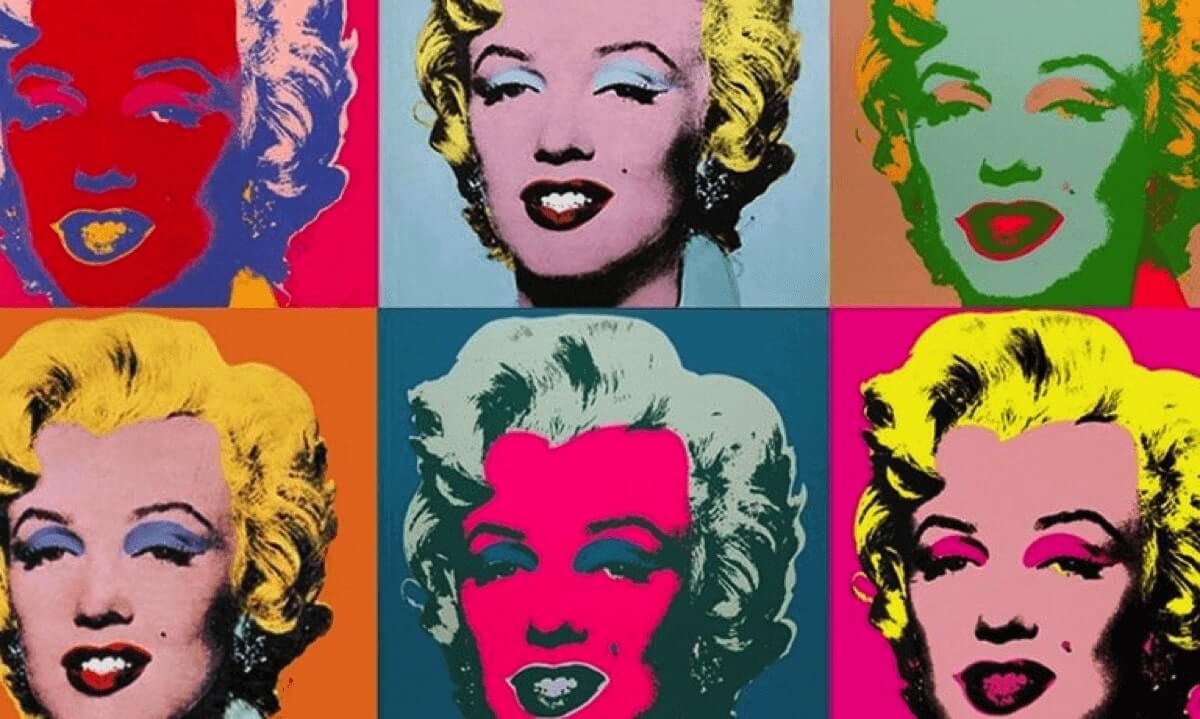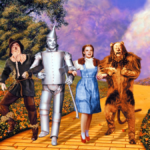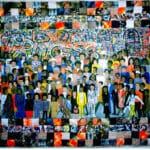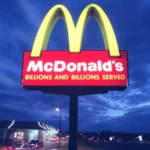Get ready for a wild ride through the crazy, colorful world of pop art! This groovy movement exploded onto the scene, shaking up the art world and turning everyday objects into masterpieces. From the iconic soup cans to the mind-bending works of Warhol and Lichtenstein, we’ll dive into the secrets behind this captivating art style. Prepare to uncover the juicy tidbits and behind-the-scenes stories that make pop art the irresistible crowd-pleaser it is today.
Fun Facts About Pop Art
Pop art wasn’t just some stuffy art movement – it was like a party bursting into a museum! Imagine walking into a gallery and seeing giant sculptures of hamburgers and ice cream cones, or entire buildings wrapped in fabric! That’s the kind of playful energy that artists like Claes Oldenburg and Christo and Jeanne-Claude brought to the table. Speaking of tables, have you ever looked at a can of soup and thought, “Hey, that’s art!”? Well, Andy Warhol did, and his iconic Campbell’s Soup paintings made everyone rethink what could be considered beautiful.
But Pop Art was more than just playful sculptures and soup can art. It was a total game-changer, challenging the very idea of what art should be. By grabbing images from everyday life – think comic books, advertisements, and even soup cans! – Pop artists made us question who gets to decide what’s “original” and what’s not. It’s like they were saying, “Hey, even the stuff we see every day can be art if we just open our minds a little!”
And open our minds they did! Pop Art’s influence spread faster than you could say “Roy Lichtenstein.” Suddenly, its bold colors and playful spirit were everywhere: fashion, music, graphic design – you name it! It was a revolution in how we saw the world around us. Even today, the echoes of Pop Art are still felt. Contemporary artists keep finding inspiration in its themes of consumerism and mass media, proving that its impact goes way beyond those iconic soup cans.
What are 5 interesting facts about pop art?
So, we’ve talked about what Pop Art is all about – the bright colors, the everyday objects turned into art, and how it shook things up in the art world. But did you know there’s a whole lot more to this movement than meets the eye? Let’s dive into some lesser-known facts that make Pop Art even more fascinating!
- Pop Art’s Rebellious Beginnings: Imagine a time when art was all about serious brushstrokes and hidden meanings. That’s what the art scene was like in the mid-1950s, dominated by something called Abstract Expressionism. Then, bam! Pop Art bursts onto the scene, like a breath of fresh air (or maybe a can of Campbell’s Soup, if you’re thinking like Andy Warhol!). These artists were like, “Enough with the seriousness!” They decided to make art about things everyone knew – things from ads, comics, and even grocery store shelves. It was a total rebellion against the art world’s norms, and boy, did it turn heads!
- Pop Art Goes International: Now, when you think of Pop Art, you probably picture America, right? And yeah, the US was a hotbed for the movement. But here’s the thing: Pop Art wasn’t just an American party! Across the pond, British artists like Peter Blake and Richard Hamilton were adding their own spice to the mix. They brought their own ideas and styles, proving that Pop Art wasn’t just a passing fad – it was a global phenomenon that spoke to something bigger.
- Technology Meets Art: Pop artists weren’t afraid to get their hands dirty with the latest gadgets. They were like the tech-savvy artists of their time! Think silkscreens, mass-produced prints, and all sorts of techniques that blurred the line between art and technology. This was a big deal because it meant art wasn’t just for the elite anymore. Prints and posters meant that regular folks could finally afford to bring a piece of Pop Art into their homes.
- Pop Art’s Hidden Messages: On the surface, Pop Art is all bright colors and fun images, right? But don’t let that fool you! Artists like Warhol and Lichtenstein were masters of irony and satire. Their art wasn’t just about celebrating consumerism – it was also about questioning it. They used their art to hold up a mirror to society, making people think about the influence of advertising and the things we value in a world obsessed with stuff.
- Pop Art Lives On! Here’s the cool thing about Pop Art: it didn’t just fade away like a trend. Its impact is still felt today, from the clothes we wear to the designs we see all around us. Pop Art’s bold aesthetic continues to inspire artists, designers, and creatives of all stripes. Even if you don’t realize it, you’re probably encountering the legacy of Pop Art in your daily life!
So, there you have it! Pop Art is full of surprises, blending art, culture, and a healthy dose of social commentary. It’s a movement that reminds us that art can be found in the most unexpected places and that even the everyday can be extraordinary.
It’s important to note that our understanding of art movements like Pop Art is always evolving. Art historians are constantly digging deeper, uncovering new connections, and reinterpreting works through the lens of contemporary thought. So, what we consider “fact” today might be seen in a new light tomorrow, making the study of art history a dynamic and ever-changing field.
What are 10 Unique Characteristics of Pop Art?
So we’ve talked about how Pop Art exploded onto the scene, but what makes it so special? What sets it apart from the art that came before? Let’s dive into some of the key ingredients that make Pop Art so unique:
- Everyday Stuff Becomes Art: Forget fancy landscapes and serious portraits, Pop Art thought the stuff we see every day was pretty cool. Think soup cans, comic strips, and even those flashy ads you see on billboards. Pop artists said, “Hey, this stuff is part of our lives, why not make it art?”
- Blurring the Lines: Before Pop Art, there was this big invisible wall between “high art” (think museums and fancy galleries) and “low art” (think comics and posters). Pop Art decided to knock that wall down! They took everyday images and presented them in a way that made people rethink what could be considered “real art.”
- A Side of Criticism with Your Soup?: While Pop Art loved celebrating everyday things, it also had a bit of a rebellious streak. Some artists used their work to poke fun at consumerism – you know, how we’re constantly bombarded with ads and told to buy, buy, buy. It was like holding up a mirror to society and its obsession with stuff.
- Color? Don’t Be Shy!: Open your eyes wide, because Pop Art is all about bold, vibrant colors! Think bright reds, electric yellows, shocking pinks – the kind of colors that jump off the canvas and grab your attention. This wasn’t about subtle hints; it was about making a statement.
- Inspired by the World Around Us: Forget dusty old history books – Pop artists found their inspiration in the world around them! Comic books, advertisements, movies, even celebrity photos – it all became fair game. This connection to popular culture is a big part of why Pop Art feels so immediate and relatable.
- Don’t Forget to Laugh!: Who says art has to be serious all the time? Pop Art wasn’t afraid to have a little fun. They injected humor and irony into their works, often with a playful wink to the viewer. It was art that didn’t take itself too seriously.
- Borrowing and Remixing: Pop artists weren’t afraid to borrow images from other sources – think familiar faces from ads or iconic comic book panels. This “appropriation” wasn’t about stealing; it was about re-contextualizing these images and making us see them in a new light.
- The Power of Repetition: Have you ever noticed how the same image or logo gets repeated over and over in advertising? Pop artists noticed too, and they used repetition in their work to highlight the influence of mass production and consumer culture on our lives.
- Go Big or Go Home: Some Pop artists thought, “Why have a small painting when you can have a HUGE one?” They created massive works of art that were impossible to ignore – think giant soup cans or enormous comic strip panels. It was about making a statement and grabbing your attention in a big way.
- A Global Phenomenon with Local Flavor: Pop Art might have started in the United States and the UK, but it quickly spread all over the world. And as it traveled, it picked up different flavors and influences from different cultures. This means that Pop Art isn’t just one thing – it’s a whole family of styles with unique characteristics that reflect their own time and place.
Want to learn more? This is just scratching the surface! Pop Art is a fascinating movement with a rich history and a lasting impact. There’s so much more to discover, so keep exploring and see what other secrets you can uncover about this exciting art movement!
What is Unique About Pop Art?
We’ve been talking about Pop Art, and one of the coolest things about it is how it totally shook up the art world. It wasn’t afraid to use things from everyday life – stuff everyone knew and saw all the time. Think soup cans, comic books, even celebrities! Pop Art said, “Hey, these things are important too!” It showed how our culture was changing, how we were becoming obsessed with brands and products.
Some folks saw it as a big joke, using this ordinary stuff in art. But that was kind of the point! Pop artists were often being ironic. They wanted to make us think about how consumerism was taking over, how we were surrounded by advertising and media. It was like holding up a mirror to society.
Think of Andy Warhol and his famous Campbell’s Soup Cans. It makes you wonder, is he celebrating this soup, or is he pointing out how much it’s shoved in our faces? It’s this playful questioning that makes Pop Art so interesting.
And guess what? Pop Art is still a big deal today! Fashion designers, advertisers, even musicians borrow from its bold style. It’s like its influence just won’t quit. And that’s probably because it tapped into something really important about our culture, something that still rings true today.
It’s important to remember that we’re still figuring out Pop Art’s full impact. Art historians are constantly debating its meaning and influence. So, keep exploring, keep asking questions, and see what YOU make of it!
What are some interesting facts about pop art for kids?
Pop art? It was like throwing a party for everything around us! Imagine taking a simple can of soup from your kitchen and turning it into a painting – that’s what pop artists did! They looked at everyday stuff – comic books, soup cans, even those celebrity photos in magazines – and said, “Hey, this is art too!” And guess what? They weren’t afraid to use the brightest, most awesome colors you could find, just like the ones in your box of crayons!
Speaking of celebrities, pop artists loved playing with their images. One famous artist, Andy Warhol, made tons of paintings of Marilyn Monroe, but they weren’t your typical portraits. They were colorful, kinda funny, and made you see Marilyn in a whole new light. It was their way of saying, “Hey, even famous people are part of our pop culture world!”
And you know all those ads we see everywhere? Pop artists noticed them too! They started making art that looked a lot like advertisements, using bright colors and bold letters. Some people think they were just trying to be cool and trendy, but others think they were trying to make us think twice about buying so much stuff. It’s like they were saying, “We live in a world of things, but what’s really important?”
Think of pop art like looking through a special pair of glasses that make everything more fun and exciting. It’s like art that wants to be your friend, reminding you to find the joy in ordinary things. Who knows, maybe you have some awesome pop art ideas hidden inside you, just waiting to be shared with the world!
What are 5 interesting facts about art?
We’ve been talking about some amazing stuff in the art world, but buckle up because things are about to get even more intriguing. Let’s dive into some fascinating tidbits about art that might surprise you!
- Ever heard of a little movement called Pop Art? Well, back in the 1950s, a bunch of artists started feeling like abstract expressionism, which was all the rage at the time, had become a bit too, shall we say, “out there” and detached from everyday life. They wanted art to connect with people on a more relatable level. So, what did they do? They launched Pop Art! Think soup cans, comic strips, and those catchy ads you see – they saw art in the mundane, elevating ordinary objects to the status of masterpieces. It was a total game-changer!
- Speaking of Pop Art, these guys were masters of borrowing (but in a good way!). They drew inspiration from everything around them, especially popular culture. Movies, TV shows, ads, comic books – you name it, they incorporated it into their artwork. It was like they were blurring the lines between what was considered “highbrow” art and the things people enjoyed in their daily lives. Pretty cool, huh? Did you know that the first snowman was made in 1380? For more snowman facts, click right here.
- But here’s the thing about Pop Art – it wasn’t just about pretty pictures; it had a message too. These artists weren’t afraid to use a little irony and humor to make a point. They poked fun at consumerism, questioned our obsession with celebrities, and made us see the world from a different perspective. Take Andy Warhol’s famous soup can prints, for example. Some people might see them and think, “It’s just a soup can,” but there’s a deeper meaning there. It makes you think about mass production, our relationship with everyday objects, and how we assign value to things.
- Now, let’s talk about art’s impact on society. You see, Pop Art wasn’t just about challenging artistic norms; it was also about making art more accessible to everyone. By using familiar imagery and themes, they invited everyday folks to engage with art in a way they hadn’t before. It was like they were saying, “Hey, art isn’t just for the elite; it’s for everyone!” And do you know that the Tmall headquarters is in Hangzhou, China? Click here to learn more about Tmall.
- And you know what’s even more interesting? Our understanding of art is always evolving! What might be considered groundbreaking today could be old news tomorrow. There’s always something new to discover, new movements to explore, and new perspectives to consider. So, the next time you see a piece of art, don’t just glance at it – take a closer look, ask questions, and see where it takes you. You might be surprised by what you find! How about learning some intriguing facts about wheelbarrows, like, did you know that the first wheelbarrow was invented in China around 200 B.C.?
What gave pop art its name?
So, we’ve been talking about Pop Art, this super cool art movement that exploded onto the scene in the mid-20th century. But have you ever wondered where it got its catchy name? Well, we can thank British art critic Lawrence Alloway for that! Back in 1955, he used the term “Pop Art” to describe this exciting new art form that wasn’t afraid to embrace the everyday stuff, the things people saw all around them.
Think about it: “Pop.” It’s short, snappy, and kinda reminds you of those fizzy sodas and catchy tunes that were all the rage back then. Alloway saw a connection between this new art and the explosion of popular culture and mass-produced goodies that were taking the world by storm. He recognized that artists like Andy Warhol and Roy Lichtenstein weren’t just painting pretty pictures; they were holding up a mirror to society, using images from comics, advertisements, and even soup cans to make us think about consumerism and the things we value.
While Alloway’s term stuck like glue, it’s important to remember that the art world is full of debate! Some folks believe that the term “Pop Art” might have been floating around in conversations even before Alloway put pen to paper. But no matter who officially coined the term, one thing’s for sure: “Pop Art” perfectly captures the movement’s spirit – bold, accessible, and impossible to ignore. It’s like they took a snapshot of everyday life and turned it into art, making us see the extraordinary in the ordinary.
What are Interesting Facts About Pop Art?
So, we’ve been talking about Pop Art, right? It’s like this wave of art that washed over everything back in the 1950s and totally changed the game. You know how some folks say art has to be all deep and serious? Well, Pop Art was like, “Hold my beer.” It dove headfirst into the stuff we see every day – soup cans, comic books, those bright, flashy ads – and turned them into, well, art!
Think about Andy Warhol. He’s like the king of Pop Art. You’ve probably seen his Campbell’s Soup Can paintings – super simple, but they make you stop and think. Then there’s Roy Lichtenstein, the guy who made those comic book-style paintings with the thick black outlines and dots. These guys weren’t afraid to use bold colors and techniques straight from the advertising world.
And that’s a big part of what Pop Art is all about: taking stuff from pop culture – movies, ads, you name it – and mixing it all together. It’s like they were blurring the lines between what’s considered “high art” and the stuff we love in our everyday lives. But it wasn’t just about being playful; Pop Art often used humor and irony to poke fun at things like consumerism and celebrity culture. It reflected those big cultural changes and anxieties people were feeling back then.
One of the coolest things about Pop Art is that it wasn’t meant to be stuck in some stuffy museum. It was for everyone! Pop artists wanted their work to connect with ordinary people, and it did. Even today, Pop Art’s influence is everywhere, from art galleries to T-shirts. It’s a reminder that art can come from anywhere and that sometimes the most everyday objects can spark our imaginations.
It’s worth noting that experts are still exploring Pop Art and its impact, so there’s always something new to discover!
What are 5 Interesting Facts about Andy Warhol?
Okay, so you know Andy Warhol – the king of Pop Art, the guy behind the Campbell’s Soup cans. But did you know he was way more than just a painter? Here are some tidbits about Warhol that might surprise you:
- Movie Buff Alert: Warhol Actually Started with Film! Believe it or not, this art superstar wasn’t just about canvases and paintbrushes. He was obsessed with movies, making over 60 films in his career. And get this – he even founded Interview Magazine, a super cool magazine that talked all things artsy and rubbed shoulders with big-time celebrities. Talk about a Renaissance man!
- Hold Up, He Was a TV Star Too? Forget just being on TV, Warhol had his own shows! He hosted “Andy Warhol’s TV” and “Andy Warhol’s TV Fifteen Minutes,” proving that this guy was a natural in front of the camera, blending art and entertainment like a boss.
- Welcome to The Factory: Where the Cool Kids Hung Out: Picture this: a studio bursting with energy, buzzing with the biggest names in art and Hollywood. That was Warhol’s Factory. It was the place to be, where creative minds collided, and Warhol’s signature style was born.
- From Pittsburgh to the Big Apple: While Warhol was originally from Pittsburgh, it’s pretty clear that New York City got under his skin – in a good way. The city’s vibrant art scene and electrifying energy had a massive impact on his work, making it his forever home.
- A Touch of Slovakia: Everyone knows Warhol as an American icon, but there’s more to the story. His Slovakian heritage is like a hidden layer in his art, waiting to be explored. Some experts believe it subtly influenced his artistic choices and the things he chose to portray, adding an extra layer of depth to his work.
The Bottom Line:
Andy Warhol wasn’t just an artist; he was a force of nature. From painting and film to magazines and TV, he was everywhere, constantly pushing boundaries and redefining what it meant to be an artist.
What is true about pop art?
So, we’ve been talking about Pop Art, this super cool movement that popped up (pun intended!) in the mid-1950s. It totally shook things up in the art world. But what’s really true about it? Well, it’s more than just bright colors and famous images. Let’s dive a little deeper and uncover some surprising facts!
First off, Pop Art was all about celebrating the stuff we see every day. Think about it – soup cans, comic books, those things we usually just pass by? Pop artists saw beauty in them, turning them into art! They believed that even the most ordinary things had a place in the art world. Imagine that – a Campbell’s soup can hanging in a fancy gallery!
And that leads us to the next point: Pop Art really messed with the idea of what’s considered “high art” and “low art.” Before this, galleries were mostly filled with super serious, often abstract, pieces. But Pop Art? It threw all that out the window! They used images from ads, popular brands, and even celebrities. It was like they were saying, “Hey, this stuff is part of our lives too, why can’t it be art?”
But hold on, there’s more to it! Pop artists weren’t just having fun with everyday images. They often used their art to make a point, subtly (or not so subtly) poking fun at society. Think about it – by showing us these everyday things blown up huge and colorful, they made us think about consumerism, the media, and even the way we worship celebrities. Pretty clever, right?
Now, you might be thinking, “All this sounds interesting, but is it really for everyone?” And that’s the beauty of Pop Art! Unlike some art movements that can feel a bit exclusive, Pop Art was all about being relatable. It used familiar images and ideas that everyone could connect with, making art more accessible and less intimidating.
And you know what? Pop Art’s influence is still going strong today! You can see it everywhere – in modern art, graphic design, fashion, even in the way brands market themselves. It’s like the spirit of Pop Art, its playfulness and boldness, never really went away.
So, there you have it! Pop Art wasn’t just a passing trend; it was a movement that truly changed the way we think about art and its place in our world. It reminds us that art can be found anywhere, even in the most unexpected places, and that it has the power to make us think, question, and see the world in a whole new light.
How Old is Pop Art?
So, we’ve been chatting about Pop Art, and you might be wondering, “Just how old is this whole Pop Art thing anyway?” Well, it’s not like some ancient artifact we dug up! It’s actually a bit like that cool vintage clothing style you love – it has roots in the past but still feels surprisingly fresh today.
Think back to the mid-1950s. Abstract Expressionism was all the rage in the art scene – lots of splatters and feelings, you know? But some artists, especially in Britain and the U.S., were starting to feel like something was missing. They were tired of the seriousness and wanted to shake things up. They wanted art that spoke to everyone, not just the art critics. And guess what? They found inspiration in the most ordinary places – soup cans, comic books, celebrities in magazines – things we see every single day! They took those everyday images and turned them into art.
This new wave of art, dubbed “Pop Art,” wasn’t just about making art from unusual things. It was a way to make us think about the stuff we’re surrounded by, the things we buy into. They used bright colors and bold designs, sometimes even throwing in a good dose of humor to make their point. Imagine Andy Warhol’s famous Campbell’s Soup Cans – he wasn’t just painting soup; he was making us question our obsession with consumerism.
And you know what? People loved it! Pop Art wasn’t locked away in stuffy museums; it was in your face, on posters, in magazines, even on furniture. It was art for the people, by the people, reflecting the world we live in.
But here’s the thing about Pop Art – its influence didn’t fade with time. It’s like the cool older sibling that keeps inspiring new generations. Think about street art, graphic design, even the way brands market themselves today – you can see those Pop Art vibes shining through. It made us realize that art doesn’t have to be this high-brow, untouchable thing. It can be fun, thought-provoking, and yeah, even a little bit rebellious.
Pop Art reminds us that inspiration can be found anywhere, even in a simple can of soup. It’s a movement that continues to make us question, to see the extraordinary in the ordinary, and to never take ourselves too seriously. And that, my friend, is why we’re still talking about it all these years later.
- Sept 31 Myth: Unveiling Calendar Secrets - March 18, 2025
- How Long & Till December 18, 2025: Accurate Countdown Guide - March 18, 2025
- Discover Japanese Artists: A Complete History - March 18, 2025

















3 thoughts on “Fun Facts About Pop Art You Never Knew”
Comments are closed.